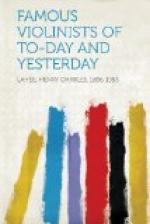In regard to this accomplishment of playing on one string, a critic said: “To effect so much on a single string is truly wonderful; nevertheless any good player can extract more from two than from one. If Paganini really produces so much effect on a single string, he would certainly obtain more from two. Then why not employ them? We answer, because he is waxing exceedingly wealthy by playing on one.” Paganini seems to have reasoned from the opposite point, viz., that if the retention of two strings be regarded with such wonder, how much greater the marvel will be if only one is used.
To offset these suggestions of charlatanism, or perhaps rather to show that, with all his charlatanism, Paganini was a marvel, we may see what effect his playing had upon some men who were not likely to be caught by mere trickery. Rossini, upon being asked how he liked Paganini, replied: “I have wept but three times in my life; the first, on the failure of my earliest opera; the second time, when, in a boat with some friends, a turkey stuffed with truffles fell overboard; and thirdly, when I heard Paganini play for the first time.”
Spohr, after hearing him play, in 1830, said: “Paganini came to Cassel and gave two concerts, which I heard with great interest. His left hand and his constantly pure intonation were, to me, astonishing; but in his compositions and his execution I found a strange mixture of the highly genial and the childishly tasteless, by which one felt alternately charmed and disappointed.”
George Hogarth, the musical critic, writes about Paganini’s “running up and down a single string, from the nut to the bridge, for ten minutes together, or playing with the bow and the fingers of his right hand, mingling pizzicato and arcato notes with the dexterity of an Indian juggler.” It was not, however, by such tricks as these, but in spite of them, that he gained the suffrages of those who were charmed by his truly great qualities,—his soul of fire, his boundless fancy, his energy, tenderness, and passion; these are the qualities which give him a claim to a place among the greatest masters of the art.
Perhaps the finest description of Paganini is the one written by Leigh Hunt:
“So play’d of late to every
passing thought
With finest change (might I but half as
well
So write) the pale magician of the bow,
Who brought from Italy the tales, made
true,
Of Grecian lyres; and on his sphery hand,
Loading the air with dumb expectancy,
Suspended, ere it fell, a nation’s
breath;
“Of witches’ dance, ghastly
with whinings thin,
And palsied nods—mirth, wicked,
sad, and weak;
And then with show of skill mechanical,
Marvellous as witchcraft he would overthrow
That vision with a show’r of notes
like hail;
Flashing the sharp tones now,
In downward leaps like swords; now rising
fine
Into some utmost tip of minute sound,
From whence he stepp’d into a higher
and higher
On viewless points, till laugh took leave
of him.




